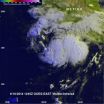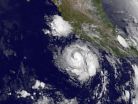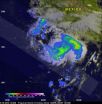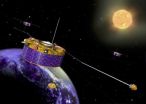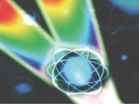(Press-News.org) Before Tropical Storm Cristina intensified into a hurricane, NASA's TRMM satellite passed overhead and gathered data that showed areas of heavy rainfall were occurring within.
The National Hurricane Center (NHC) upgraded the third tropical depression of the Eastern Pacific Ocean to tropical storm status and named it Cristina on June 10 at 0300 UTC (8 p.m. PDT). Earlier that morning at 1238 UTC (5:38 a.m. PDT), the Tropical Rainfall Measuring Mission (TRMM) satellite flew over the depression and gathered rainfall data that hinted that the storm was intensifying. At NASA's Goddard Space Flight Center in Greenbelt, Maryland, rainfall from TRMM's Microwave Imager (TMI) and Precipitation Radar (PR) were overlaid on an enhanced visible/infrared 1245 UTC (8:45 a.m. EDT) image from the GOES-East satellite to provide a view of clouds and rainfall within the storm. The TRMM TMI data showed large areas of moderate to heavy rainfall occurring west of Mexico's coast. TRMM data also showed a closed low- to mid-level ring of thunderstorms surrounding Cristina's center.
On June 11, NHC Forecaster Kimberlain noted that Cristina continues to intensify. The cyclone consists of a small central dense overcast in geostationary satellite imagery. Infrared imagery, such as that from the Atmospheric Infrared Sounder instrument aboard NASA's Aqua satellite, showed that cloud top temperatures in powerful thunderstorms in the northern semicircle of the storm are as cold as -80C (-112F). Cloud top temperatures that cold indicate strong storms with the potential to drop heavy rainfall, which complemented the data seen by the TRMM satellite on June 10. Kimberlain also noted that there were faint hints of eye or warm spot during the early morning hours of June 11.
At 5 a.m. EDT (2 a.m. PDT), Hurricane Cristina had maximum sustained winds near 75 mph (120 kph). Cristina was centered near 15.2 north latitude and 104.1 west longitude, about 265 miles (425 km) south of Manzanillo, Mexico. Cristina is moving west at 6 mph (9 kph) and is expected to turn to the west-northwest over the next couple of days, according to NHC. Minimum central pressure was 990 millibars
NOAA's GOES-West satellite captured an infrared view of Hurricane Cristina on June 11 at 1200 UTC/8 a.m. EDT off the west coast of Mexico. The image did not yet show an eye, but the NHC expects Cristina to continue strengthening so future satellite imagery may catch that eye "opening."
Although Cristina is not over land, it is close enough to cause dangerous ocean swells that are affecting portions of the south-central and southwestern coast of Mexico. NHC noted that these swells will likely continue into Wednesday, June 11, and could cause life-threatening surf and rip current conditions.
The NHC noted that the environment in which Cristina is embedded remains ideal for further intensification.
VIDEO:
NASA's TRMM satellite rainfall data was overlaid on an enhanced visible/infrared image from NOAA's GOES-East satellite showing cloud and rainfall extent. Green areas indicate rainfall at over 20 mm/hour....
Click here for more information.
INFORMATION:
Text credit: Harold F. Pierce / Rob Gutro
SSAI/NASA's Goddard Space Flight Center
Cristina now a hurricane, NASA's TRMM satellite sees heavy rainfall within
2014-06-11
ELSE PRESS RELEASES FROM THIS DATE:
The solar wind breaks through the Earth's magnetic field
2014-06-11
Space is not empty. A wind of charged particles blows outwards from the Sun, carrying a magnetic field with it. Sometimes this solar wind can break through the Earth's magnetic field. Researchers at the Swedish Institute of Space Physics (IRF) in Uppsala now have an answer to one of the questions about how this actually occurs.
When two areas with plasma (electrically charged gas) and magnetic fields with different orientations collide, the magnetic fields can be "clipped off" and "reconnected" so that the topology of the magnetic field is changed. This magnetic reconnection ...
It's the last bite that keeps you coming back for more
2014-06-11
Your memory for that last bite of a steak or chocolate cake may be more influential than memory for the first bite in determining when you want to eat it again, according to research published in Psychological Science, a journal of the Association for Psychological Science.
Our memories for foods are often vivid, especially when we experience foods that are terrifyingly bad or delightfully good. The findings from this research shed light on how memories for food are formed and how they guide our decisions about how soon we're willing to eat a food again.
"Research has ...
Obesity gene linked to hormonal changes that favor energy surplus
2014-06-11
A new study from Uppsala University demonstrates that elderly humans carrying a common variant of the fat mass and obesity gene FTO also have a shifted endocrine balance. Low blood concentrations of the satiety hormone leptin and high blood concentrations of the hunger promoting hormone ghrelin makes carriers of the FTO gene put on weight. The findings are published in the journal Diabetes.
In the Prospective Investigation of the Vasculature in Uppsala Seniors, researchers from Uppsala University and the University of Umeå used data from 985 elderly participants (50% ...
Toward 24-7 glucose monitoring to help manage diabetes
2014-06-11
Nearly half a million people with diabetes end up in emergency rooms around the U.S. every year due to the seizures and other consequences of dropping or spiking blood-sugar levels associated with the disease. To help prevent serious complications, scientists have now developed a new glucose-sensing protein that could one day be part of an implantable, 24-7 monitoring device. They describe the protein in the journal ACS Chemical Biology.
Sylvia Daunert and colleagues note that scientists have been working on new ways to track glucose levels. Most patients with diabetes ...
American Heart Association conference highlights solutions for reducing sodium intake
2014-06-11
11 June 2014 – Sodium intake around the world continues to be of concern1 and public health authorities hypothesise that it may be linked with cardiovascular disease risk2. In an effort to identify ways to reduce the amount of sodium consumed and provided in the food supply, the American Heart Association brought together over 100 key stakeholders and thought leaders at a special conference in June 2013. Proceedings from the conference were published in the May 2014 edition of Circulation3.
Among the top priorities identified by the group were increasing consumer understanding ...
Gauging local illicit drug use in real time could help police fight abuse
2014-06-11
The war on drugs could get a boost with a new method that analyzes sewage to track levels of illicit drug use in local communities in real time. The new study, a first-of-its-kind in the U.S., was published in the ACS journal Environmental Science & Technology and could help law enforcement identify new drug hot spots and monitor whether anti-drug measures are working.
Kurunthachalam Kannan and Bikram Subedi note that to date, most methods to estimate drug use in the U.S. are based on surveys, crime statistics and drug seizures by law enforcement. But much illegal drug ...
Viewing deeper into the quantum world
2014-06-11
One of the important tasks for quantum physics researchers and engineers is designing more sensitive instruments to study the tiny fields and forces that govern the world we live in. The most precise measuring instruments devised to date, such as atomic clocks or gravitational wave detectors, are interferometric in nature and operate according to the laws of quantum mechanics.
As with all quantum objects, photons – the basic building blocks of light - display a "wave-particle" duality. Interferometers exploit the wave-like behaviour of photons to measure a signal, known ...
Study finds cognitive performance can be improved in teens months, years after traumatic brain injury
2014-06-11
Traumatic brain injuries from sports, recreational activities, falls or car accidents are the leading cause of death and disability in children and adolescents. While previously it was believed that the window for brain recovery was at most one year after injury, new research from the Center for BrainHealth at The University of Texas at Dallas published online today in the open-access journal Frontiers in Neurology shows cognitive performance can be improved to significant degrees months, and even years, after injury, given targeted brain training.
"The after-effects ...
Guarding against 'Carmageddon' cyberattacks
2014-06-11
The potential value of turning the nation's freeways into "smart transportation systems" is enormous. Equipping the nation's concrete arteries with a nervous system of computers and sensors that directly control on-ramp signals to keep traffic moving smoothly can substantially reduce travel times, fuel consumption and air pollution, not to mention improve road safety. In California alone the economic penalty of traffic congestion has been estimated at $400 million in extra costs and $3.5 million in lost wages every day.
The tightly integrated computing and networking ...
Elucidating optimal biological tissue shape during growth
2014-06-11
A team of European scientists has now extended a previous biophysical model to investigate elongated growth within biological tissues by describing the evolution over time of the shape of a fruit fly's wing. They found the aspect ratio of the typical biological shapes may exhibit a maximum at finite time and then decrease. For sufficiently large tissues, the shape is expected to approach that of a disk or sphere. These findings have been reported by Carles Blanch-Mercader from the University of Barcelona, Spain, and colleagues, in a paper published in EPJ E. They provide ...
